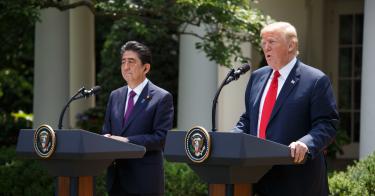U.S.-Japan trade negotiations could start any day now. Signing a deal is a top priority for both nations, this year. However, a number of hurdles have arisen, leaving a slim chance for the deal getting done before 2020.
If you asked analysts in Washington where they think a trade deal with Japan ranks on the White House’s list of trade priorities this year they would probably say third. Getting Congress to approve a U.S.-Mexico-Canada Agreement (USMCA) has the highest priority, given the volume of cross-border trade. U.S.-China negotiations would rank a close second due to moving deadlines, as well as the significant trade volume affected.
If you asked analysts in Tokyo where they think a trade deal with the U.S. ranks for the Prime Minister’s office, they would likely say it’s now the top priority. Prime Minister Abe has finished trade deals with the European Union and with signatories of the CPTPP (Comprehensive and Progressive Agreement for Trans-Pacific Partnership). The only issue left for Abe is formalizing something with the U.S..
However, despite both country’s desire to ink a deal, they hold quite different views regarding what the trade deal means and the benefits is can provide.
Japanese officials sees much more of a geopolitical benefit to signing a trade deal with the United States. They also ideally see a U.S.-Japan trade agreement as the next step to getting the U.S. to rejoin the CPTPP, given that new members are able to join now.
What the U.S. seeks from the deal is primarily economic utility. American negotiators want to regain the market access lost after withdrawing from the CPTPP and from new competition with cheaper European products.
USMCA vs CPTPP
Already, a U.S.-Japan trade deal is looking less like a free trade deal and more like a managed competition between U.S.MCA and CPTPP standards.
The negotiating priorities laid out by the Office of the U.S. Trade Representative bore a striking resemblance to the objectives of the U.S.MCA. This includes sensitive provisions like increasing production in the U.S., bringing up the issue of currency, and limiting trade deals with non-market economies like China.
Granting the U.S. oversight over the deals struck with China by Japan would be diplomatically dangerous for Tokyo. After all, Japan, China, and other members of the Regional Comprehensive Economic Partnership hope to finish a deal by the end of 2019. Japan is also negotiating a separate trade deal with China and South Korea.
Meanwhile, Japanese lawmakers have capped the concessions they’ll make on agricultural products to CPTPP’s standards.
Of course, the biggest outstanding issue for Japan is whether or not the U.S. will apply tariffs or seek quotas on Japanese autos and auto part imports under the guise of protecting U.S. national security. Doing so would not only impede the free flow of goods; it would be a shock to the U.S.-Japan alliance.
Making Time for Negotiations
While these and other issues need to be resolved, the clock is ticking. Though not impossible, it’s highly unlikely that any trade deal—even one with an ally like Japan—could get through Congress in a presidential election year. This means the U.S. and Japan must get a deal done well before the start of 2020.
For the next month, perhaps longer, the U.S. negotiators will be preoccupied with China. U.S. Trade Rep. Robert Lighthizer and Treasury Secretary Steven Mnuchin will be in Beijing February 14 and 15th laying the groundwork for a deal and an eventual meeting between Presidents Trump and Xi.
Meanwhile, Economy Minister Motegi will be in Tokyo until at least the end of March as Japan’s Diet convenes and attempts to pass a 2019 budget. After that Japan goes through a series of holidays and elections that could put negotiations on the backburner.
Potentially, the U.S. and Japan could meet on the sidelines of the June G20 meeting in Japan or even the August G7 meeting in France. But the question still remains whether it’ll be enough time to work through the outstanding issues on trade – especially if more issues arise in the meantime like auto tariffs. Even in the best-case scenario, it could take almost half a year before Congress gets around to formalizing the text that would make the deal into law under Trade Promotion Authority.
Given the short time frame, the outstanding issues, and the potential for new trading issues, I wouldn’t expect a deal to get done anytime soon. The good news is there’s still plenty of opportunities for the U.S. to work with Japan on other areas like WTO reform and e-commerce.
This piece originally appeared in The Diplomat



